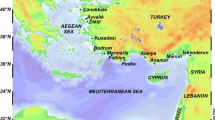Abstract
The waters of Kuwait Bay, northern Arabian Gulf, are well mixed by macrotidal, semi-diurnal tides. Sea surface temperature (SST) is thus a good proxy of water mass temperature in the bay. The factors governing SST have been conveniently sub-divided into global, regional and local drivers. This paper provides a study on long-term drivers of temperature change in the northern Arabian Gulf: that is, factors that influence decadal changes. AVHRR (NOAA) satellite data of Kuwait Bay, collected between 1985 and 2002, show that SST has steadily increased at a rate of 0.6 (±0.3)°C/decade. This trend was three times greater than the concurrent global average. The rate of change was greatest in May and June and least during winter months. The trends defined by satellite data were substantiated by routine in situ monthly measurements of SST made in the region and were also similar to air temperature trends recorded at Kuwait airport. The monthly measurements of SST also showed a peak in summer temperature coincident with an El Niño event in 1998. A relatively low summertime peak during 1991 in the aftermath of Iraqi invasion of Kuwait is considered to be the result of atmospheric dimming brought about by dense smoke that persisted in the region for most of that year.





Similar content being viewed by others
References
Al-Ghadban A, El-Sammak A (2005) Sources, distribution and composition of the suspended sediments, Kuwait Bay, Northern Arabian Gulf. J Arid Environ 60:647–661. doi:10.1016/j.jaridenv.2004.07.017
Al-Rashidi T, Amos C, El-Gamily H (2007) Utilization of remotely sensed data to detect anthropogenic impacts on sea surface temperature of Kuwait Bay, Kuwait. In: OCEANS 2007-Europe, pp 1–5. Doi: 10.1109/OCEANSE.2007.4302207
Al-Yamani F, James B, Essa R, Al-Husaini M, Al-Ghadan A (2004) Oceanographic atlas of Kuwait’s waters. KISR publication, Kuwait, pp 81–191
Anderlini C, Jacob C, Lee W (1982) Atlas of physical and chemical oceanographic characteristics of Kuwait Bay, Final report of the oceanographic data project. Kuwait Institute for Scientific Research, Report No. KISR704, pp 15–66
Giannini A, Kushnir Y, Cane M (2001) Seasonality in the impact of ENS0 and the North Atlantic High on Caribbean rainfall. Phys Chem Earth 26(2):143–147. doi:10.1016/S1464-1909(00)00231-8
GISS (2007) Global temperature trends: 2005 summation. In: GISS surface temperature analysis. Goddard Institute for Space Studies. Available via DIALOG. http://data.giss.nasa.gov/gistemp/2005/. Accessed 14 Jan 2008
Glibert P, Landsberg J, Evans J, Al-Sarawai M, Fraj M, Al-Jarallah M, Haywood A, Ibrahem S, Klesius P, Powell C, Shoemaker C (2002) A fish kill of massive proportion in Kuwait Bay, Arabian Gulf, 2001: the roles bacterial disease, harmful algae, and eutrophication. Harmful Algae 1:215–231. doi:10.1016/S1568-9883(02)00013-6
IPCC (2007) Observation: surface and atmospheric climate change. Climate change 2007: The physical science basis. Chapter 3. Fourth assessment report: Intergovernmental panel on climate change. Available via DIALOG. http://www.ipcc.ch/pdf/assessment-report/ar4/wg1/ar4-wg1-chapter3.pdf. Accessed 20 Dec 2007
Jones D, Price A, Al-Yamani F, Al-Zaidan A (2002) Coastal and marine ecology. In: Khan N, Munawar M, Price A (eds) The Gulf ecosystem: health and sustainability. Backhuys Publishers, Leiden, The Netherlands, pp 65–104
Khalaf F, Al-Ghadban A, Al-Saleh S, Al-Omran l (1982) Sedimentology and mineralogy of Kuwait Bay bottom sediments, Kuwait Arabian Gulf. Mar Geol 46:71–99. doi:10.1016/0025-3227(82)90152-9
Khan N (2007) Multiple stressors and ecosystem-based management in the Gulf. Aquat Ecosyst Health Manag 10(3):259–267. doi:10.1080/14634980701551168
Khan A, Abdu A, Murty S, Sarker A (2004) Seasonal and interannual sea surface temperature variability in the coastal cities of Arabian Sea and Bay of Bengal. Nat Hazards 31:549–560. doi:10.1023/B:NHAZ.0000023367.66009.1d
NOAA (2007) Advanced very high resolution radiometer. NOAA Satellite Information service. Available via DIALOG. http://noaasis.noaa.gov/NOAASIS/ml/avhrr.html. Accessed 20 Aug 2007
PO DAAC (2007) Physical Oceanography Distributed Active Archive Centre, Jet Propulsion Laboratory. Available via DIALOG. http://poet.jpl.nasa.gov/. Accessed 20 Feb 2007
Rakha K, Al-Salem K, Neelamani S (2007) Hydrodynamic atlas for the Arabian Gulf. J Coast Res 50(special issue):550–554
Reynolds R (2002) Oceanography. In: Khan N, Munawar M, Price A (eds) The Gulf ecosystem: health and sustainability. Backhuys Publishers, Leiden, The Netherlands, pp 55–64
Riegl B (2003) Climate change and coral reefs: different effects in two high-latitude areas (Arabian Gulf, South Africa). Coral Reefs 22:433–446. doi:10.1007/s00338-003-0335-0
Robinson I (2004) Measuring the ocean from space: the principles and methods of satellite oceanography. Praxis Publishing, Springer, UK, 280 pp
Robinson A, Brink K (2006) The global coastal ocean, interdisciplinary regional studies and syntheses. The sea: ideas and observation on progress in the study of the seas. Harvard University Press, Cambridge, MA, USA, vol 14, pp 1375–1385
Robinson I, Donlon C (2003) Global measurement of sea surface temperature from space: new perspectives. Glob Atmos Ocean Syst 9:19–37. doi:10.1080/1023673031000080385
Saeed T, Khordagui H, Al-Hashash H (1999) Contribution of power/desalination plants to the levels of halogenated volatile liquid hydrocarbons in the coastal area of Kuwait. Desalination 121:49–63. doi:10.1016/S0011-9164(99)00007-7
Sheppard C, Rayner N (2002) Utility of the Hadley Centre sea–ice and sea surface temperature data set (HadISST1) in two widely contrasting coral reef areas. Mar Pollut Bull 44:303–308. doi:10.1016/S0025-326X(02)00059-0
Smith T, Reynolds R, Peterson T, Lawrimore J (2008) Improvements to NOAA’s historical merged land–ocean surface temperature analysis (1880–2006). J Clim 21:2283–2296. doi:10.1175/2007JCLI2100.1
Swift S, Bower A (2003) Formation and circulation of dense water in the Persian/Arabian Gulf. J Geophys Res 108(C1):3004. doi:10.1029/2002JC001360
Acknowledgement
The authors would like to thank AVHRR Oceans Pathfinder project at NASA Jet Propulsion Laboratory, Physical Oceanography Distributed Active Archive Centre for the SST data and the Environment Public Authority in Kuwait for providing the field measurements for this study. We also thank the Metrological Department in Kuwait Airport for providing air temperature data. Also, special thanks to Professor Ian Robinson, Professor Robert Nicholls, Professor Andy Bradbury and Dr. Paolo Cipollini for the helpful comments in the preparation of this paper.
Author information
Authors and Affiliations
Corresponding author
Rights and permissions
About this article
Cite this article
Al-Rashidi, T.B., El-Gamily, H.I., Amos, C.L. et al. Sea surface temperature trends in Kuwait Bay, Arabian Gulf. Nat Hazards 50, 73–82 (2009). https://doi.org/10.1007/s11069-008-9320-9
Received:
Accepted:
Published:
Issue Date:
DOI: https://doi.org/10.1007/s11069-008-9320-9




